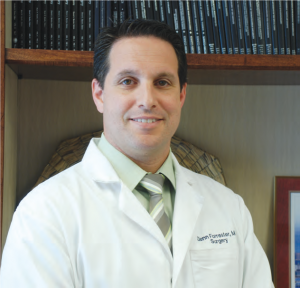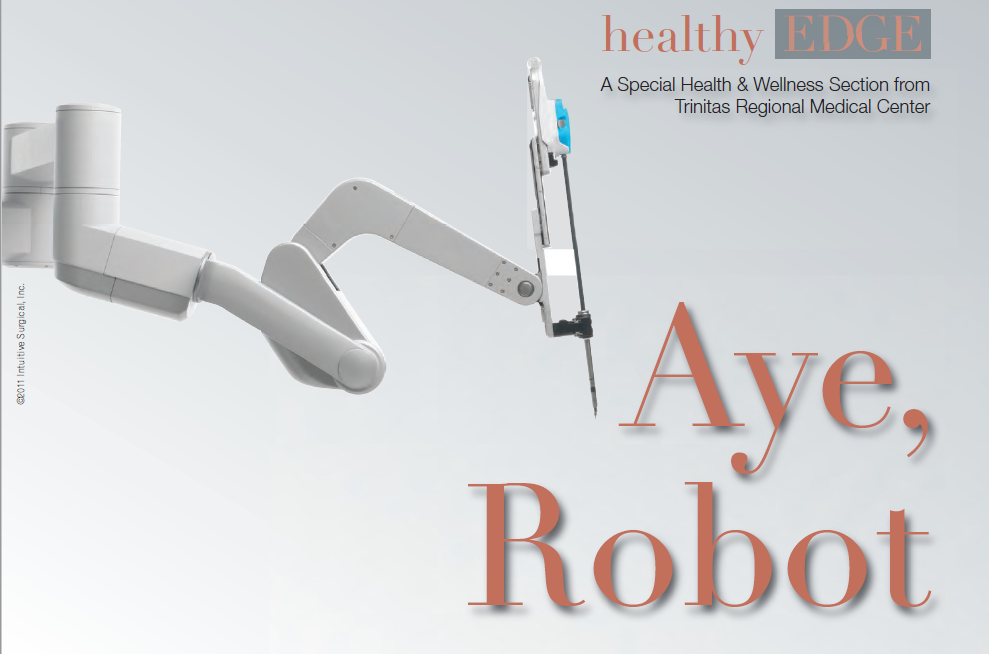Bariatric Surgeons are the Latest to Get a (Mechanical) Hand in the OR
To the layperson, the melding of humans and machines sometimes seems like the stuff of science fiction. For Trinitas surgeons working with the da Vinci Surgical System, it’s just another day at the office. Now Trinitas can claim the NY Metro area’s first Robotic Bariatric Surgery program. “This program establishes Trinitas as a Center of Excellence for Robotic Surgery,” says Gary S. Horan, President/CEO of Trinitas Regional Medical Center. “It will draw patients from all over the region, as well as many from outside the region. Trinitas also becomes the place where bariatric surgeons will come to do their training.”

Who benefits from robotic bariatric surgery? Both surgeon and patient. According to Dr. Forrester, robotic bariatric surgery may open the path to good  health to patients who in the past might have been rejected as a bariatric surgical candidate. Higher-weight patients are more challenging to operate on because their body structure places limitations on conventional laparoscopic instruments. The da Vinci diminishes the problem by giving the surgeon greater control and maneuverability. The da Vinci is also good for revisional surgeries, where a bariatric patient needs a procedure redone, or must switch from a band to a bypass. Where will robotics take bariatric surgeons in the future? Anywhere they want. Indeed, seated inside the da Vinci pod and controlling the camera, a surgeon at Trinitas could theoretically perform a bypass on anyone, anywhere. This could have interesting implications for remote parts of our own country, where obesity is epidemic and trained surgeons are few.
health to patients who in the past might have been rejected as a bariatric surgical candidate. Higher-weight patients are more challenging to operate on because their body structure places limitations on conventional laparoscopic instruments. The da Vinci diminishes the problem by giving the surgeon greater control and maneuverability. The da Vinci is also good for revisional surgeries, where a bariatric patient needs a procedure redone, or must switch from a band to a bypass. Where will robotics take bariatric surgeons in the future? Anywhere they want. Indeed, seated inside the da Vinci pod and controlling the camera, a surgeon at Trinitas could theoretically perform a bypass on anyone, anywhere. This could have interesting implications for remote parts of our own country, where obesity is epidemic and trained surgeons are few.
The da Vinci system that is utilized for bariatric procedures is already on-site. It’s the techniques and training that are new to Trinitas. A team of surgeons from the hospital has completed the rigorous training involved in mastering the da Vinci robot, which is already used for minimally invasive surgeries in a number of specialties. For some of its training, the team had to fly to Maine. Of the three types of bariatric surgeries—gastric bypass, sleeve gastrectomy and gastric banding—that can be performed robotically, the bypass lends itself especially well to the da Vinci system, explains Glenn Forrester, MD, FACS, Director of Bariatric Surgery at Trinitas. The bypass requires the most fine suturing and the da Vinci allows for the exact placement of the sutures, he says. “Another significant advantage,” adds Dr. Forrester, “is that the surgeon controls the camera throughout the operation.  During a normal laparoscopic procedure, an assistant handles the camera. This gives surgeons more control over where their eyes are trained. Imagine wanting to look at something and having someone else controlling your eyes.” In a robotic procedure, the surgeon is removed from the side of the operating table. The standard operating team is around the patient. Above the patient cart is the robotic arm. There is one surgical assistant on hand to perform tasks like retracting and stapling.
During a normal laparoscopic procedure, an assistant handles the camera. This gives surgeons more control over where their eyes are trained. Imagine wanting to look at something and having someone else controlling your eyes.” In a robotic procedure, the surgeon is removed from the side of the operating table. The standard operating team is around the patient. Above the patient cart is the robotic arm. There is one surgical assistant on hand to perform tasks like retracting and stapling.
The surgeon operates remotely — with fingers manipulating ultra-responsive individual controls and feet working pedals that focus the camera and control energy to the devices. The surgeon views the procedure through a high-definition 3-D monitor. To perform robotic bariatric procedures, surgeons must receive training from da Vinci and training from Trinitas. It typically requires four days of training and observing procedures, and between 5 and 15 supervised procedures before a surgeon gets the green light to fly solo. On top of that, additional annual training is required, as the procedures and technology evolve. Is there a fear factor among patients when they hear that a robot will have a hand in the surgery? “Patients understand that it’s not a robot doing the surgery,” Dr. Forrester smiles. “The surgery is robotic-assisted. The da Vinci is only a tool.” Soon, he says, this will be viewed as just another instrument in the operating room. “Robotic bariatric procedures are safe and effective without altering the outcomes.” Any trepidation on the part of bariatric surgeons? “No,” says Dr. Forrester. “Surgeons have a technological side and the da Vinci lets us take our ability to help patients to a whole new level.”





